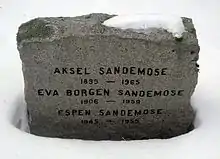Aksel Sandemose
Aksel Sandemose (né Axel Nielsen; 19 March 1899 – 6 August 1965) was a Danish-Norwegian writer.[1]
Aksel Sandemose | |
|---|---|
 | |
| Born | Axel Nielsen 19 March 1899 Nykøbing Mors, Denmark |
| Died | 6 August 1965 (aged 66) Copenhagen, Denmark |
| Nationality | Danish-Norwegian |
| Occupation | Writer |
Biography
Axel Nielsen was born at Nykøbing Mors on the island of Mors in Denmark. His parents were Jørgen Nielsen (1859–1928) and Amalie Jacobsdatter (1861–1926). His father was a factory owner. He was the second youngest of nine children. He attended Staby vinterlærerskole 1915–1916. His mother was originally from Sandermosen at Maridalen in Aker, Norway. He changed his surname to Sandemose in 1921.[2]
Sandemose boarded a schooner for Norway at the age of seventeen. He was a sailor and lumberjack in Newfoundland. He worked as a teacher at Nykøbing in 1916 and at Glyngøre in Skive during 1917. In 1930, Sandemose moved to Norway, and lived in Nesodden south of Oslo. After the Nazi German occupation of Norway during World War II, he fled to Sweden in 1941 due to his peripheral association with the Norwegian resistance movement. After the liberation of Norway, he moved back and settled in Søndeled.[3]
Sandemose published his first book in Denmark during 1923. His most notable work was En flyktning krysser sitt spor (1933). The novel was translated into English and published under the title A Fugitive Crosses His Tracks in 1936 by Alfred A. Knopf. In this novel, Sandemose introduced the concept of the Law of Jante, a listing of ten cultural rules which describe a pattern of group behaviour towards individuals common to Nordic countries.[4] [5] [6]
He was also an essayist and journalist. For a number of years he had a regular column in the weekly magazine Aktuell. Sandemose was awarded the Dobloug Prize during 1959 and was one of six finalists for the Nobel Prize in Literature in 1963.[7]
Personal life
Sandemose first married began in 1921 with Dagmar Ditlevsen (1896–1984); their marriage was dissolved in 1944. In 1944 Eva Borgen (1906–1959) and he married. As a widower, his marriage with Hanne Holbek began in 1962. Sandemose fathered five children over his lifetime. He was the grandfather of illustrator and children's writer Iben Sandemose. Sandemose died in Copenhagen in 1965 and was buried at Vestre gravlund in Oslo.[2][8]

Bibliography
- 1923 Fortællinger fra Labrador
- 1924 Ungdomssynd
- 1924 Mænd fra Atlanten
- 1924 Storme ved jævndøgn
- 1927 Klabavtermanden
- 1928 Ross Dane
- 1931 En sjømann går i land
- 1932 Klabautermannen
- 1933 En flyktning krysser sitt spor
- 1936 Vi pynter oss med horn
- 1939 September
- 1945 Tjærehandleren
- 1946 Det svundne er en drøm
- 1949 Alice Atkinson og hennes elskere
- 1950 En palmegrønn øy
- 1954 Rejsen til Kjørkelvik
- 1958 Varulven
- 1960 Murene rundt Jeriko
- 1961 Felicias bryllup
- 1963 Mytteriet på barken Zuidersee
References
- "Aksel Sandemose". H. Aschehoug & Co. Retrieved 1 May 2018.
- Jorunn Hareide. "Aksel Sandemose". Norsk biografisk leksikon. Retrieved 1 May 2018.
- Erik Bjerck Hagen. "Aksel Sandemose". Store norske leksikon. Retrieved 1 May 2018.
- Lila MacLellan. "The happiness of the Danes can easily be explained by 10 cultural rules". Quartz at Work. Retrieved 1 May 2018.
- "A Fugitive Crosses his Tracks (Knopf. 1936)". Hathi Library Trust. Retrieved 1 May 2018.
- A Fugitive Crosses his Tracks by Aksel Sandemose | Kirkus Reviews.
- "Candidates for the 1963 Nobel Prize in Literature". Nobel Prize. 2013. Retrieved 3 January 2014.
- Barthold Halle. "Iben Sandemose". Norsk biografisk leksikon. Retrieved 1 May 2018.
Other sources
- Steen Andersen (2015) Nye forbindelser. Pejlinger i Aksel Sandemoses forfatterskab (Vordingborg: Attika) ISBN 9788775288700
- Christopher S. Hale (2005) Aksel Sandemose and Canada: A Scandinavian Writer's Perception of the Canadian Prairies in the 1920s (Regina, Saskatchewan: Canadian Plains Research Center) ISBN 9780889771840
| Wikimedia Commons has media related to Aksel Sandemose. |